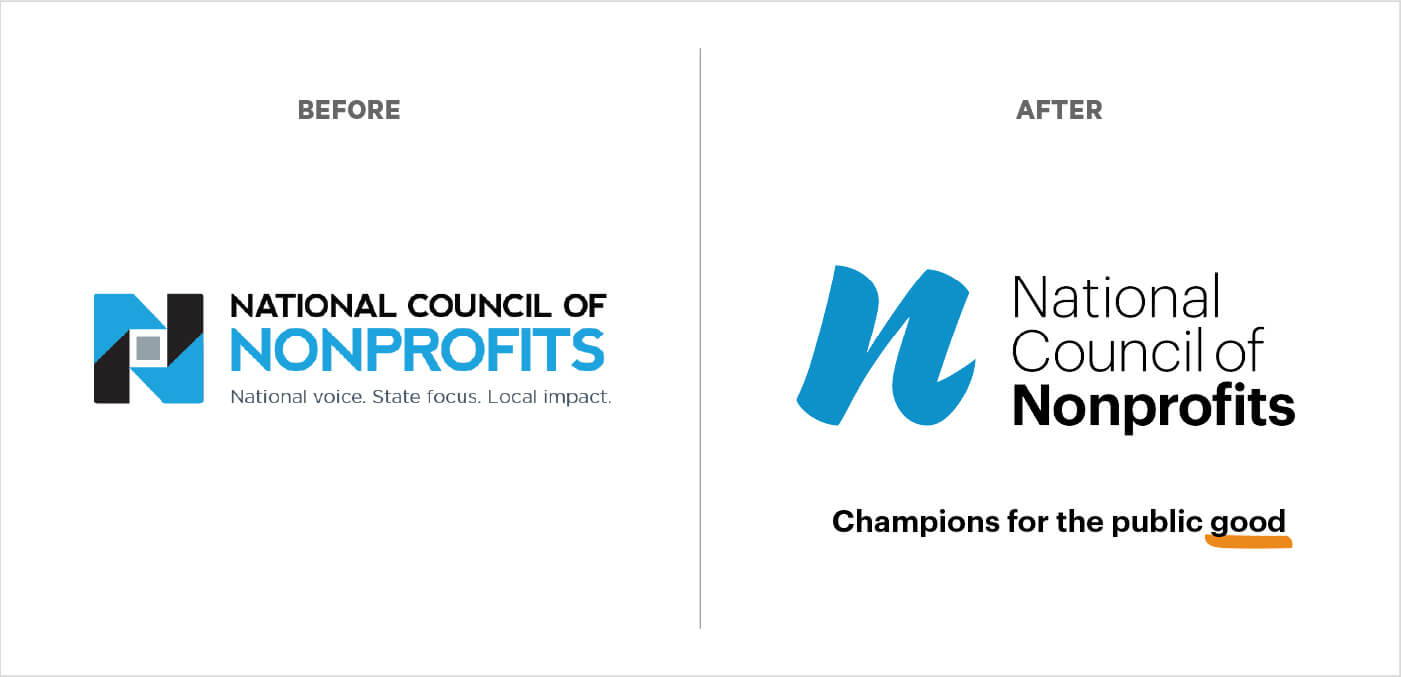Refinement vs. full refresh – behind the scenes on the National Council of Nonprofits rebrand
In 2020, the National Council of Nonprofits hired Big Duck to help them develop a new brand strategy, create a new tagline, refine their visual identity, and craft a new messaging platform to more clearly communicate their mission and commitment to grow the collective voice and power of the nonprofit community.
When we began our work together, they intended only to explore minor refinements to their logo mark, looking at things like color and typography. However, during our brand strategy workshops, together we identified an opportunity to bring their new brand personality (tenacious, expert, caring, powerhouse, and nimble) to life through a slightly different approach and evolve their logo. We ended up keeping the core idea of their logo mark, an “N” which ties into their national reach, as well as their focus on nonprofits, but we evolved the “N” to better embody their new brand strategy, and updated the typography and color palette. While still an evolution of its existing logo, the new identity emphasizes their brand strategy and is a clean, compelling design system that will help them engage existing and new audiences.

I chatted with Rick Cohen, Chief Communications Officer/Chief Operating Officer at the National Council of Nonprofits, about the changes to their brand and the large impact that these smaller changes have had.
What sparked the National Council of Nonprofits’ rebranding efforts?
We had just completed a business planning process and heard clearly through that process that our visual and written identity didn’t match the power and nimbleness that people identified with our organization. There was a golden opportunity to make some updates to better capture who we are and the impact we make.
Why did the National Council of Nonprofits want to preserve the key ideas in the logo mark and not pursue a full visual rebrand initially?
We had been building our profile within the sector and on Capitol Hill and were gaining a lot of traction, to where our logo was being recognized. So we were hesitant at first about the effort it would take for a new look to gain the same recognition.
What was the process like for you and your team when you decided to move a bit further away from your original logo than you originally anticipated?
It was really something that the Big Duck opened our eyes to. There was an opportunity for our brand to further embody the attributes that people already saw in our organization. The Big Duck team helped us evolve the logo, so it wasn’t a huge departure, but it also better reflected who we are. That evolution introduced a feeling of movement to the logo, which had been missing.
Beyond the logo, you also introduced a new tagline: Champions for the public good, updated vision, and values, new messaging, and more back in January 2022. What are some of the initial outcomes of your rebrand?
Tremendous excitement. When we shared a preview of the new branding with key stakeholders, the universal response was “Yes! This is a powerful articulation of who you are, what you do, and the impact you make.”
How have your member associations and the greater community responded to the updated logo and new brand elements?
There was appreciation for how “nonprofits” were kept front and center in the logo, continuing to center the groups we work with and for. The tagline is particularly powerful because it’s a collective tagline. It’s not just about us. It’s about our members. It’s about all nonprofits. It’s about the people who come together as staff members, board members, donors, and volunteers. Collectively, we are champions for the public good.
What advice would you give to other nonprofits considering an evolution of their existing brand vs. a full overhaul?
I think the decision will really depend on their circumstances. Sometimes you are looking for an evolution and sometimes you are looking for a revolution. The key is being open to seeing where the research and potential opportunity take you.






